Maybe you'd like to enter a short fun run or a more serious challenge like a half-Marathon, or would like to upgrade from walking to running in your next City2Surf? You want to challenge yourself and see what you can do when you really set your mind to something!
Before completing the event, you need to be sure that you will be safe, and that it will be a satisfying and uplifting experience rather than an ordeal. How can you get there with painlessly, safely and quickly?
First, a few non-negotiables:
Tip 1: Get medical clearance
If you have a medical condition, consult your doctor before planning to enter any event and don't go ahead if you're advised against it on medical grounds. It's just common sense.
Tip 2: Train appropriately
What is training for? Yes, it's about improving your performance, but it's also about risk management and injury prevention. You can enter a marathon with zero preparation, except that you are very unlikely to complete it and, more importantly, almost certain to injure yourself in the process.
Tip 3: Be realistic
Don't demand miracles of yourself. It's realistic for an averagely fit 40-year-old beginner to complete a marathon in a year's time, but it's going to take consistent effort and planning: you're going to have to become a confident 5km, 10km and half-marathon runner along the way. It's about progressively managing the risk of injury and illness: you have to build up the resilience to complete each successive stage of training. For most new runners, completing a marathon on six months' preparation is inadvisable because the risk of injury is just too high.
If your training gets a bad setback and you can't make it up in time, change your plans. Go for a later event!
Tip 4: Always warm up before training
As a runner, injury is your number 1 enemy. Warm-up and stretching are indispensable tools of injury prevention.
Pre-training warm-up should consist of dynamic movements: calf raises, leg swings and squats are all good. The aim is to get the heart pumping, the breathing a little elevated, and to warm up the synovial fluid in your joints. The synovium is the membrane sac containing fluid that lubricates the meniscuses (cartilage surfaces) in your joints. When you move, you secrete more synovial fluid into your joints and what you already have becomes a bit less viscous and sticky, enabling the joint to move more freely.
Tip 5: Always stretch afterwards.
Post-training stretches are where you should go closer to the limits of your range of motion, so we use static stretches that give your muscles time to extend fully. We'll discuss some specific stretches later. Studies show that stretches are most effective when held for about 20 seconds at a time: holding for longer than this does not give any measurable benefit.
Note that it's not the best idea to loosen up with static stretches before exercising, as increasing the range of motion available during exercise can increase the risk of injury as joints are more easily extended to their absolute limits and beyond.
Tip 6: Drink plenty of water (but don't go completely nuts!)
To perform optimally, muscles have to be well-hydrated. This also applies to the membranes or fascia layers that enclose the muscle bundles and allow them to slide over each other: fascia is very high in water content. If you are well-hydrated, you will feel more energetic and be less susceptible to cramp.
Those are what you might call the basic rules.
If you train consistently and stay just within your limits, you will see improvements over time. Please try to overcome the occasional urge to push too hard - this may well end in tears, metaphorically or literally. Have fun exploring your new capabilities.
Happy running!
*Disclaimer: Individual results vary based on agreed goals. Click here for details.

